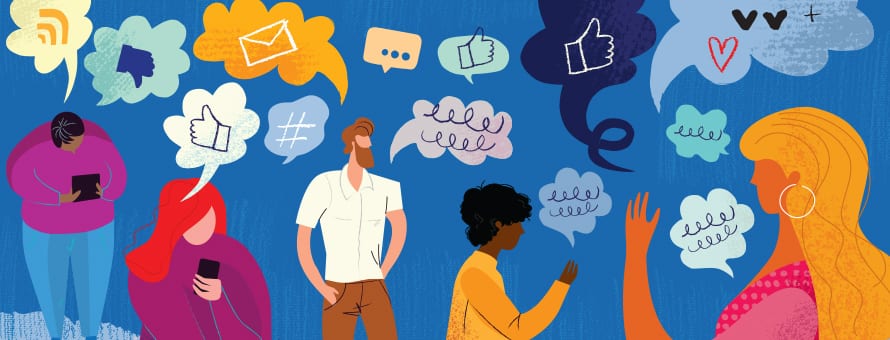Types of Communication Styles And How to Identify Them

Communication allows us to express our thoughts, share information and connect with other people. From sending a quick text to chatting with a friend over coffee, you are interacting with the people around you all the time. Whether it's verbal or nonverbal, communication makes up a big part of your life.
But who we are also shapes how we communicate. Just like no two people are exactly the same, everyone has their own unique communication style. Knowing what these styles look like — and how to identify them — can help you better communicate and work with other people.
What are the 4 Types of Communication Styles?
There are many ways to describe how a person communicates. One way is through their communication style.
Dr. Daria S. LaFave, a communication instructor at Southern New Hampshire University (SNHU), points to these styles as a tool that can help you understand others. In addition to her work as an instructor, LaFave works as a consultant for online course development and conducts research on subjects such as instructor-student relationship building and instructional design.
According to LaFave and other business leaders, communication can be categorized into four main styles:
- Passive Communication often looks like not communicating at all for fear of speaking up. This can lead to misunderstandings.
- Aggressive Communication tends to be driven by anger and judgment and can also result in inflexibility. This can create a hostile environment.
- Passive-Aggressive Communication might mean you don’t directly communicate your feelings, but you hold on to negative emotions and let those affect your actions. This can cause confusion and resentment.
- Assertive Communication is confident but also respectful of others' thoughts and feelings. Assertive communication creates space for honest conversations and promotes healthy connections between individuals.
 "These four types are pretty good at capturing styles of communication," said LaFave, who teaches classes such as interpersonal communication and communication theory, where these styles come into play. "However, it is important to consider the contexts, the relationships and the purposes of interactions when identifying these styles," she said.
"These four types are pretty good at capturing styles of communication," said LaFave, who teaches classes such as interpersonal communication and communication theory, where these styles come into play. "However, it is important to consider the contexts, the relationships and the purposes of interactions when identifying these styles," she said.
According to LaFave, you may feel as though you align with one of these communication styles, or you might feel like you use a mix of all four. For example, a person may adopt a more assertive communication style in a professional setting but switch to a more passive style when talking with family or close friends. "Style fluidity is a useful strategy for anyone who is looking to become a competent communicator," said LaFave.
What Other Factors Affect How Someone Communicates?
While sorting types of communicators can help you understand someone's habits or reactions, these styles don’t always tell the whole story.
"Interpersonal communication is multifaceted," said Dr. Jim Owston, a communication instructor at SNHU. According to Owston, it's hard to define someone by just one communication style. If someone is using an aggressive communication style in a meeting, that doesn't mean it's the style they use all the time.
With over 30 years of teaching experience and 20 years working in broadcasting, Owston points to some key factors that he has seen impact how someone communicates, including:
- Cultural and social conventions
- Gender and social roles
- Emotions and perception
- Environment or medium
These additional factors can explain why someone communicates the way they do. But they can also explain how other people interpret those messages.
For example, being an assertive communicator is often seen as a good thing. An assertive communicator is direct with their message while still being respectful of others' thoughts and feelings.
"In some instances (though)," LaFave said, "assertiveness can come across as aggression, which could have negative impacts on the person who is asserting themselves."
LaFave points to gender as one outside factor that can negatively affect how communication is interpreted. While assertiveness may be praised in men, "women are more likely to be seen as aggressive when they assert themselves," she said. It's important to think about how your communication style comes across and what factors may affect how you view someone else's style, too.
Find Your Program
How Do You Identify Communication Styles?
According to LaFave, being able to identify someone's communication style can help you:
- Develop and deliver your message clearly
- Avoid or prevent conflicts
- Achieve your goals
- Build successful relationships
But how do you go about analyzing their style? The answer may mean looking at a range of factors.
1. Consider Your Relationship
 How someone communicates can be based on their role or your relationship to them.
How someone communicates can be based on their role or your relationship to them.
“If you are dealing with a superior, it might help to identify that person’s leadership style and leadership traits,” said Owston. On the other hand, if you want to know how a romantic partner communicates, it may be more helpful to learn about their love language.
According to Owston, understanding how someone communicates is crucial in building effective relationships. He encourages first recognizing how your relationship may influence your interactions. You can tailor your approach to that specific scenario.
2. Employ Active Listening
Active listening is a useful strategy that can help you identify someone’s communication style.
"Active listening means listening not just with our ears but also with our eyes and with our heart," said LaFave. "We can do that by asking questions that seek to understand the meaning behind what is being spoken." To LaFave, active listening also means not jumping to conclusions.
For example, if someone is speaking in a direct and concise manner, active listening can help you determine the reasons behind that choice. You might assume they are being aggressive, but in reality, they may just be short on time.
“Different communication styles emerge in an interaction," LaFave said, "but accurate understanding of the style comes with time and patience."
3. Think About Emotional Intelligence
To help you understand someone's communication style, both LaFave and Owston recommend reflecting on your level of emotional intelligence as well as that of the person you're talking to.
LaFave points to five aspects of emotional intelligence that can contribute to our communication patterns:
- Empathy: The ability to put yourself in someone else's shoes, acknowledging their emotions and experiences.
- Self-awareness: Being able to recognize your own emotions, strengths and weaknesses and how these impact others as well as your own decision-making.
- Social skills: How you connect with people to build positive and meaningful relationships.
- Self-regulation: Not allowing negative feelings to get the best of you in tough situations.
- Motivation: Knowing what is inspiring the choices that you make.
"The balance of these elements impacts the style of our communication," said LaFave. "For example, people who struggle with empathy or self-regulation may be more prone to communicate aggressively or passive-aggressively."
In LaFave’s experience, people with more skill in these areas often have higher emotional intelligence; therefore, they tend to communicate more successfully with other people.
"Identifying a person’s emotional intelligence will best help in understanding how and why a person communicates," said Owston. "But understanding your own emotional quotient will also aid in communicating with others."
How Does Culture Affect Communication Styles?
Culture is a big part of communication. Everyone comes into an interaction with their own set of values, beliefs and experiences.
According to the U.S. Department of State, someone's communication style can be impacted by the role context plays in their culture:
- High context communication: This style tends to focus more on relationships, formality and hierarchy, with someone shifting how they communicate based on a specific scenario.
- Low context communication: This style is often straightforward and personal, with people saying exactly what they mean and focusing on getting tasks done.
It can be confusing when somebody else communicates in a style you're not used to. You may not be sure how to respond in some situations. Or maybe you don't understand why someone reacted to something that seemed normal to you.
"We all carry with us implicit biases that we may or may not be aware of," said LaFave. "Before we even begin speaking, we form impressions of another person based on our initial observations, past experiences and even biases that we may or may not be aware of."
Miscommunications and misunderstandings can get in the way of building strong relationships, so it can be helpful to know that everyone speaks in their own way. When working with someone from another culture or country, take some time to learn more about their cultural communication norms.
What Do Communication Styles in the Workplace Look Like?
Communication is an important soft skill to work on and can benefit both your personal and professional life. In the workplace, you may find that your personal style complements or clashes with the styles of your coworkers.
"Someone with an aggressive communication style may come across as hostile and authoritarian, alienating others and creating a harmful work climate," said LaFave. But sometimes, a more aggressive style can be helpful in a specific situation. She said the same aggressive communicator can be the perfect fit for a different project or organization needing to optimize time and resources.
In addition to someone's communication style, a project can also be affected by how clear someone's message is.
"If instructions and the nature of the task are not clear to those (working on) the project, there will be problems," Owston said. "It is important for the leader of the project to clearly communicate the goals and outcomes of the project. SMART goals are one tool that can help in this regard."
If someone's communication is vague, it can lead to misunderstandings and delays in completing tasks. Clear and concise communication means everyone understands their roles and responsibilities, leading to more efficient collaboration and successful outcomes.
How Do Digital Spaces Affect Communication Styles?
You may be used to doing a lot of your communication online, either via text message or email. Your communication style online will be similar to your style face-to-face, but you may have to make some adjustments.
“The primary problem with digital communication is that it lacks significant nonverbal cues,” said Owston. “Nonverbal cues can be expressed when someone types in ALL CAPS, marks up passages in bold text or underlined text or has an overuse of exclamation points!!!!!! These can all be perceived negatively.”
Without nonverbal cues, the reader can insert their feelings and emotions into your message. What you intended to sound assertive can come off sounding aggressive if someone reads your message the wrong way. Being aware of what you’re writing — and how you’re writing it — can ensure that your message is clear over text or email.
To Owston, this means:
- Choosing your words carefully.
- Avoiding “you” language, as it implies the sender is pointing fingers at the receiver.
- Typing messages in a word processor first to avoid accidental sending.
- Using spell check and grammar check on all of your messages.
If you're going to send something that may be misunderstood or taken in the wrong way, Owston encourages waiting 24 hours before sending that text or email. "See if you have the same feeling that you did the previous day," he said. "You probably won’t."
How Can Someone Improve Their Communication Skills?
Some people seem to be natural communicators, but communication is a skill that you can build over time.
"The best way to improve our communication is to learn and to practice," said LaFave. "It helps to set specific goals and work through them as we engage in everyday interactions."
One way to improve your communication skills is to focus on your listening skills. "This might look like practicing active listening and trying to identify another question to ask about whatever is being discussed," said LaFave. Instead of simply reacting to what someone is saying, responding thoughtfully might be a good goal to set.
Owston adds that there are small ways you can work on your communication skills every day. He encourages anyone trying to be a better communicator to:
- Ask questions.
- Make interactions about the individual and not about yourself.
- Remember how you say something is more important than what you say.
Strong communicators are an important part of any successful team. Working on your communication skills might not only be about identifying other people's communication styles — but also reflecting on your own. By putting effort into being a skilled communicator, you can improve your relationships, prevent misunderstandings and understand other people better.
Discover more about SNHU's communication degree: Find out what courses you'll take, skills you'll learn and how to request information about the program.
Meg Palmer '18 is a Southern New Hampshire University graduate and a writer, who also teaches English at the university level.
Explore more content like this article

What Can You Do With an English Degree?

Academic Spotlight: Dr. Christopher Lee, Associate Dean of English Programs

SNHU Spotlight: Ashley Smith, BA in Communication Grad
About Southern New Hampshire University

SNHU is a nonprofit, accredited university with a mission to make high-quality education more accessible and affordable for everyone.
Founded in 1932, and online since 1995, we’ve helped countless students reach their goals with flexible, career-focused programs. Our 300-acre campus in Manchester, NH is home to over 3,000 students, and we serve over 135,000 students online. Visit our about SNHU page to learn more about our mission, accreditations, leadership team, national recognitions and awards.


